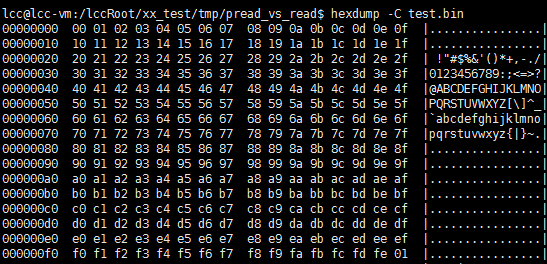pread 和 pwrite 函数是 linux 下 C 语言编程中非常好用的 IO 操作函数。它们属于系统调用,在 2.1.60 之后版本的 linux 下都可以使用,尤其适合用于多线程的应用中,它们允许多个线程操作同一个文件描述符,不会互相影响彼此的文件偏移(offset)。
pread 和 pwrite 函数
所需头文件和函数原型
#include <unistd.h>
ssize_t pread(int fd, void *buf, size_t count, off_t offset);
ssize_t pwrite(int fd, const void *buf, size_t count, off_t offset);
函数说明
pread和pwrite函数从文件描述符 fd(可由open函数获得)描述的文件的 offset 偏移处,读写 count 字节数据。
如果是读,读出的内容通过buf传出。如果是写,写入的内容由buf传入。
它俩的返回值与read和write函数类似,成功时,pread和pwrite函数分别返回成功读出或者写入的字节数。如果调用失败,返回 -1,失败码可从errno查出。
pread/pwrite 和 read/write 函数的联系和区别
以写入函数为例,pwrite函数在单线程的情况下,相当于 lseek和write函数的组合:
pwrite(fd, buf, len, offset);
/** 相当于 */
lseek(fd, offset, SEEK_SET);
write(fd, buf, len);
只不过,在 fd文件描述符没有O_APPEND属性的情况下,write函数会修改文件偏移指针,下次不seek写入位置直接调用write函数时,write函数会接着上次的位置继续写入(offset+len)。而pwrite函数则不会改变文件偏移指针。
另外,很重要的一点是,pwrite函数的seek和写入是原子操作,不会因为进程调度或者其他因素中断。而对于lseek和write的组合,因为两个语句之间存在间隙,进程调度线程切换有可能发生在其间,导致写入的数据出错。
pread/pwrite 和 read/write 函数的实例demo对比
下面这段代码的功能很简单,就是创建了两个线程,一个线程负责顺序往 test.bin 文件顺序写入 0~254 的整数,另外一个线程则负责从中顺序读出。编译后,程序接收一个参数,1表示只从test.bin中读取,2表示只往test.bin中写入,3表示同时读写test.bin。
lseek和read/write的组合在多线程同时读写中的表现
pread/pwrite在多线程同时读写中的表现
现在来试试pread/pwrite函数的表现如何,我们将代码中的lseek和read/write注释,取消pread/pwrite的注释:
...
// lseek(fd, i, SEEK_SET);
// read(fd, &j, 1);
pread(fd, &j, 1, i);
...
// lseek(fd, i, SEEK_SET);
// write(fd, &i, 1);
pwrite(fd, &i, 1, i);
...
再编译,做相同的测试:
$ gcc pread_vs_read.c -lpthread
lcc@lcc-vm:/lccRoot/xx_test/tmp/pread_vs_read$ ./a.out 3
w_thread: 0
r_thread: 0
w_thread: 1
r_thread: 1
...
$ ./a.out 1
r_thread: 0
r_thread: 1
r_thread: 2
r_thread: 3
r_thread: 4
r_thread: 5
...
发现数据被正确写入了。
总结
可以看出,pread/pwrite更适合在多线程编程中使用。当然,非要用read/write也可以,只是需要自行做好线程同步,这就比pread/pwrite麻烦了许多。
